|
Page < 1 2 3 4 5 6 7 8 9 10 11 12 13 14 15 >
A Glorious Hindu Legacy: Indic influence in Southeast
Asia.
Hinduism in
Thailand
The Spread of
Indian Culture in South East Asia
The history of the expansion
of Indian civilization to the east has not yet been told in its
entirety. The relations between India proper and Farther India
date back to prehistoric times. But the eastward expansion of
Hindu civilization has not yet been fully traced.
Recently
an Ancient
statue of Lord Vishnu
has been found in Russian
town of the Volga region.
For more refer
to chapter on Suvarnabhumi.
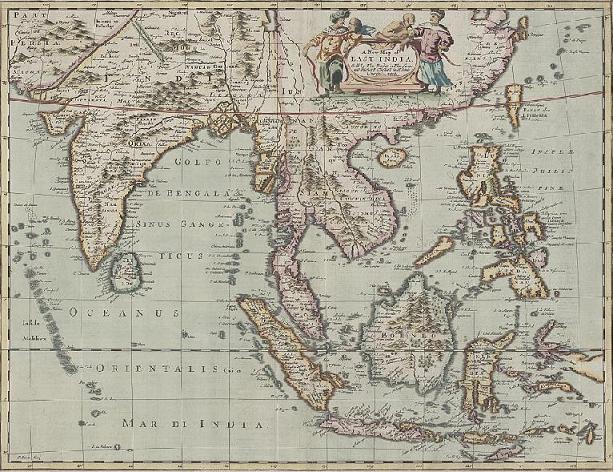
Map of Greater
India.
The history of the expansion
of Indian civilization to the east has not yet been told in its
entirety. The relations between India proper and Farther India
date back to prehistoric times. Many
non-Indian scholars, especially modern writers of secondary
works, tend to play down India's importance for obvious reasons,
in the evolution of
Southeast Asian civilization.
(image
source: Digital
Collection - National Library of Australia).
***
Many
non-Indian scholars, especially modern writers of secondary
works, tend to play down India's importance in the evolution of
Southeast Asian civilization.
Some scholars
(such
as Mary
Somers Heidhues of the
Univ. of Hamburg in her book
Southeast
Asia – A Concise History
on page 22 have
downplayed India's cultural ties to South east Asia by claiming
that Indians brought with them their "cultural baggage" to
Southeast Asia.
(Note:
Perhaps, Ms. Heidhues
should also remember that the Puritans in America and the
British rulers in India, also brought their cultural baggage
with them).
She then proceeds on page 64 to
call Ramayana and Mahabharata
as "epic folk tales".
The Ramayana and Mahabharata have
been a constant source of comfort, guidance, and entertainment
to millions down the ages. Whereas the Homeric Epics have never
been sacred books and have long since ceased to occupy a central
position in Greek culture, the Indian Epics are the most widely
read and respected religious books of the Hindus today. One
wonders why Ms. Heidhues has labeled India's grand epics as
"folk tales" ? Are the Iliad and Odyssey ever called
"folk tales"?
Others have tried to portray Buddhism as an improvement over Hinduism.
(Note:
It is as similar to
portraying Christianity is an improvement over Judaism).
However, Karma and Nirvana are both Hindu concepts and Pali was born
out of Sanskrit, just like Italian came out of Latin.
Indianization
must be understood essentially as the expansion of an organized
culture that was founded upon the Indian conception of royalty,
was characterized by Hinduism or Buddhism, by the Puranas, and
the observance of the Dharmasastras, and expressed itself in the
Sanskrit language.
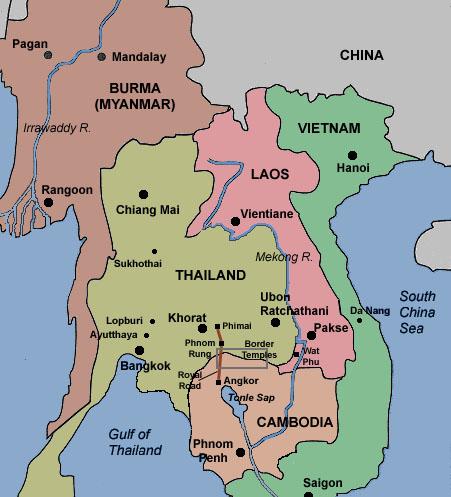
Hindu civilization
spread to Siam in early times from about 2nd century A.D.
The
Hindus set up many colonies in Siam and the most important of
them was Dvaravati which
ruled from Cambodia to the Bay of Bengal up to the 10th century
A.D.
***
Ancient
Thailand
The northeastern part of Thailand
had come under the influence of the Hindu Kingdom of Funan at a
very early period. Later, when northeastern Siam fell to the Khmers,
its Indian character was further strengthened. The southern part
of Siam, however, was most directly and continuously in contact
with India. Large numbers of Indian merchants, settlers, and
teachers came to southern Siam in successive waves either
directly or from India or through Burma. Southern Siam is full
of remains of Indian culture, most prominent of which is the
city of Nakhon Srithammarat.
Three
sanctuaries - the Bot Prahm with numerous Shivalingas, the San
Pra Isuon containing bronze statues of Shiva, Parvati and Ganesh,
and the Na Pra Narai with its renowned statues of Vishnu - are
amongst the excavations made at this site. According to the
LIang Shu, there possibly existed in the region in the
first
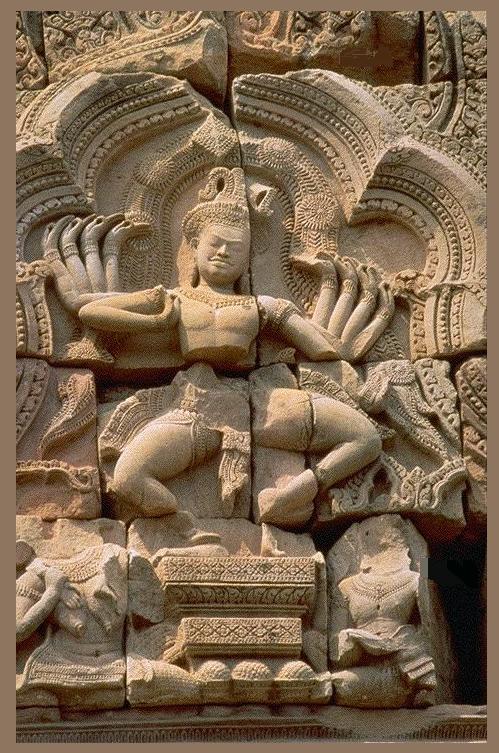
Shiva Nataraja.
***
Hindu civilization
spread to Siam in early times from about 2nd century A.D. The
Hindus set up many colonies in Siam and the most important of
them was Dvaravati which
ruled from Cambodia to the Bay of Bengal up to the 10th century
A.D. when it was overthrown by the Kaundinya kingdom. Numerous
excavations have yielded extensive evidence of Indianization and
some remarkable piece of art. Because Siam increasingly
assimilated Indian art and culture into a local pattern, relics
of pure Indian descent are more ancient than those reflecting
local influences. One of the most remarkable sites in the center
of Siam, is Srideb (Crip-teb),
where statues of Hindu deities bearing Sanskrit inscriptions of
the 5th and 6th century have been discovered. The art of Srideb
is of excellent quality and provides a link between Indian art
and the art of Southeast Asia.
Dr.
H G Quartich Wales ( ? ) considered Srideb the oldest known
Hindu temple in Southeast Asia.
The Khmer legacy in
Thailand was considerable. Some Khmer sites, such as Sukhothai
and Sri Satchanalai, was retained by the Siamese as foundations
for their own cities and temples. The Siamese script was derived
directly from the more complex Khmer system.
Prasat
Phom Rung
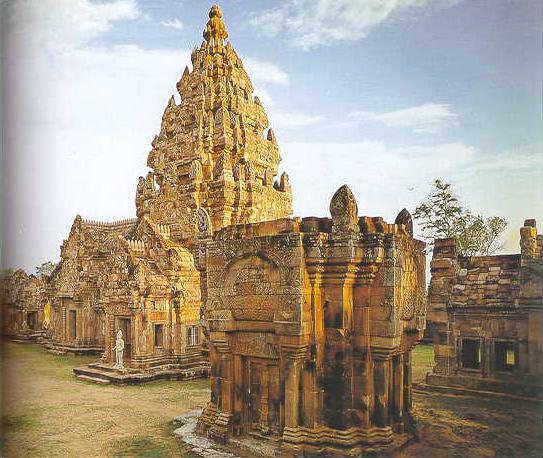
Phnom Rung:
Lord Shiva's mountaintop abode.
(image
source: Angkor: Splendors of the Khmer
Civilization - By Marilia Albanese p. 274 -
275).
***
This major temple,
built manly in a high quality pinkish sandstone combines an
impressive hill-top site that commands the surrounding plain,
and an extraordinary amount of architectural decoration of the
highest order.
Phnom
Rung was built atop an extinct volcano in a series of raised
platforms to symbolize Shiva’s mountaintop abode. Located
in isolated and spectacular splendor on an enormous overhanging
cliff in the Dongek Mountains, this is without question the most
magnificent site of any Khmer temple. It was laid out in a
north-south axis with only one entrance, and most of the large
monuments here were built as a microcosm of the Hindu universe,
a magical recreation on Earth of the home of the gods and the
surrounding seas and continents.
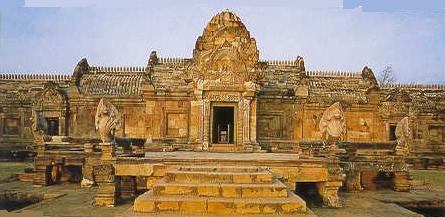
The east gopura,
preceded by a platform surrounded by nagas leads into the temple
enclosure.
(image
source: Angkor: Splendors of the Khmer
Civilization - By Marilia Albanese p. 274 -
275).
Eleven inscriptions
have been found at Phnom rung. Prasat
Phanom Rung is the province’s landmark archaeological site. It
dates back to the seventh and eighth century. A Khmer lord was
responsible for completing most of the present structure, which
exemplifies the splendour of ancient Khmer arts, architecture
and culture. Within the Prasat, is a throne hall built in the
12th century A.D. The beauty of the
main prang of Phanom Rung lies not only in its plan, but in the
vibrant stone carvings which cover large parts of the temple.
Many lintels and pediments depict episodes from Indian texts
such as the Ramayana, and
the Puranas.
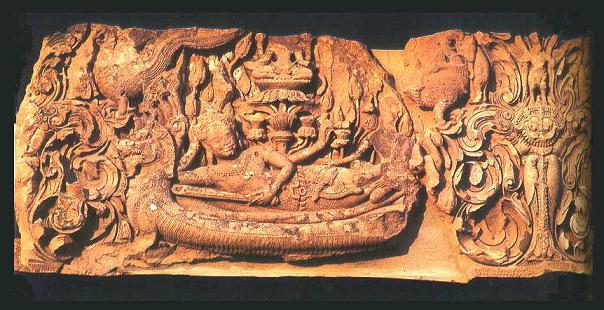
Lord Vishnu on
Ananta Nag, reclining over the mandapa entrance.
The
lintel depicting one of the most famous Hindu creation stories
at Phnom Rung was the subject of a celebrated dispute, having
been stolen from the temple in the early 1960s. It then appeared
at the Chicago Art Institute, on loan from a private collection.
(For
more refer to chapter on Greater
India: Suvarnabhumi and
Sacred
Angkor).
***
“The
ancient architecture is a sort of symbol, portraying the Sumeru
Mount or Krairat Mount, or reflecting an ethical system. The
ancient temple also represents an image of the universe.
That’s why at the middle of the temple there is always a
mountain-like structure, which represents the highest idealism
in Buddhism or Hinduism. Only those who practice virtue at the
highest level can reside at this high place,” he said.
“We
should not intrude into the ancient sites, except for
appreciating the value or the faith of the people who lived in
the past.”
Isaan
claims a rich legacy of splendid Khmer architecture. Among the
best known are Phanom Rung, Preah Vihear, Phimai, and Muang Tham.
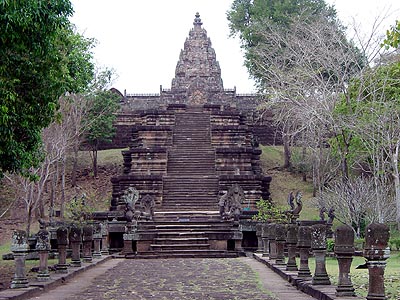
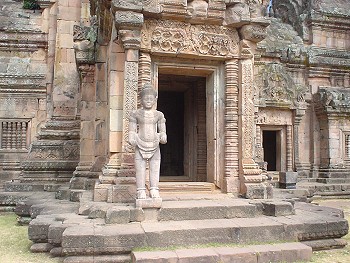
Built on top of
an extinct volcano.
According
to Thaitourism.com, Prasat Phanom Rung is built of sandstone and
laterite, 402 metres above sea level on the rim of an extinct
volcano on the Buri Ram plain in southern Isaan. Lava is still
scattered around the top. In former times the crater was a
natural baray or reservoir. Most of the present structure was
built by a local Khmer lord in the 12th century. The structure,
however, overlies a series of earlier brick temples, which,
judging from the earliest of eleven inscriptions found at Phanom
Rung, date back to at least the 7th and 8th centuries.
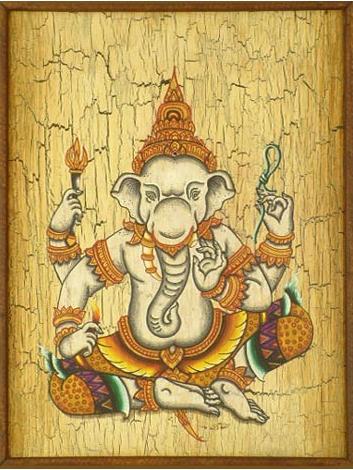
Thai Lord
Ganesha.
The
temple is dedicated to Lord Shiva, but has many prominent images of
Brahma, Vishnu, Ganesh, and Nandin. A long avenue leading up to
a broad staircase and a terrace ends in five-headed naga
(mythical snakes). A gateway opens onto the central courtyard
containing the main sanctuary. The lintel over the eastern porch
of the main sanctuary is comprised of two parts: the upper part
depicts a 10-armed dancing Shiva and on the lower part, Vishnu
floats on the ocean while sleeping on a snake.
(source:
Wat
Phra Narai Maharat on
Prachak Road houses an image of Narayana
(Lord Vishnu) made of sandstone. This statue is
considered the major sacred object of the city. The City Pillar
is also enshrined in this temple

Prang
Sam Yot - This Hindu temple was built during the time that Thailand was
under the Angkor, or Cambodian empire.
(image
source: Andreas
Hörstemeier - wikipedia.org).
***
Prang
Sam Yot - This Hindu temple was built during the time that Thailand was
under the Angkor, or Cambodian empire. The Thai kingdom of
Sukhotai broke free of the Angkor Empire in the mid 1200's, and
Lop Buri was soon absorbed into it. This temple was then
rededicated as a Buddhist temple.
Originally
a Hindu shrine, the Prangs represent Brahma, Vishu, and Shiva
(the Hindu trinity). It was later converted to a Buddhist
shrine.
Prasat
Narai Jaeng Waeng - 11th century during the reign of
Udayadityavarman II. A small sandstone temple on a high laterite
platform. The lintels and pediments are all interesting, and
there is a fine Somasutra
(Stone pipe or channel through which the lustral waters used to
wash the image inside the sanctuary are drained, projecting
outside the temple. Often terminates with a carved makara head
of a serpent. Indicative of a Shaivite temple) still in situ-
one of the very few throughout the remains of the Khmer empire.
This is the most northerly Khmer sanctuary still in good
condition. The name is both unusual and reflects the history of
the region - Narai is the Thai name for Lord Vishnu, but jaeng
waeng is old Khmer, meaning 'long legs'. The entire name
presumably refers to the reclining Vishnu on the northern
pediment.
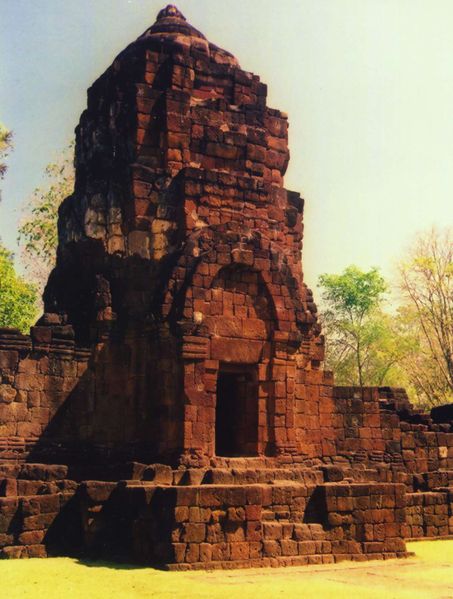
Prasat Muang
Singh also known as Sri Jayasinhapur - City of the Victorious
Lion.
(image
source: Andreas
Hörstemeier - wikipedia.org).
Prasat
Muang
Singh in Kanchanapuri -
Late 12th century. The name Prasat Muang Singh means 'Sanctuary
of the City of the Lion'. The inscription of the stele at Preah
Khan at Angkor,
still in situ, mentions Srijayasimhapur (City of the Victorious
Lion) as one of the places to which Jayavarman VII had ent a
Jayabuddhamahanatha statue. This ancient Khmer city is located
about 45 km from Kanchanaburi, on the banks of the Kwai Noi
River.
Muang
Singh's importance lies in its strategic location, on the route
west to the Three Pagodas Pass that crosses into Burma. No doubt
it was a garrison town to guard and protect this western limit
of the Angkor Empire, but also it was probably a trading center.
(source:
A Guide to Khmer Temples in Thailand
and Laos - By Michael Freeman p. 168 - 195 and 238 -
240). (For more refer
to chapter on Greater
India: Suvarnabhumi and
Sacred
Angkor). For a documentary
on Hindu temples, refer to The
Lost Temples of India.
Top
of Page
Page < 1 2 3 4 5 6 7 8 9 10 11 12 13 14 15 >
|